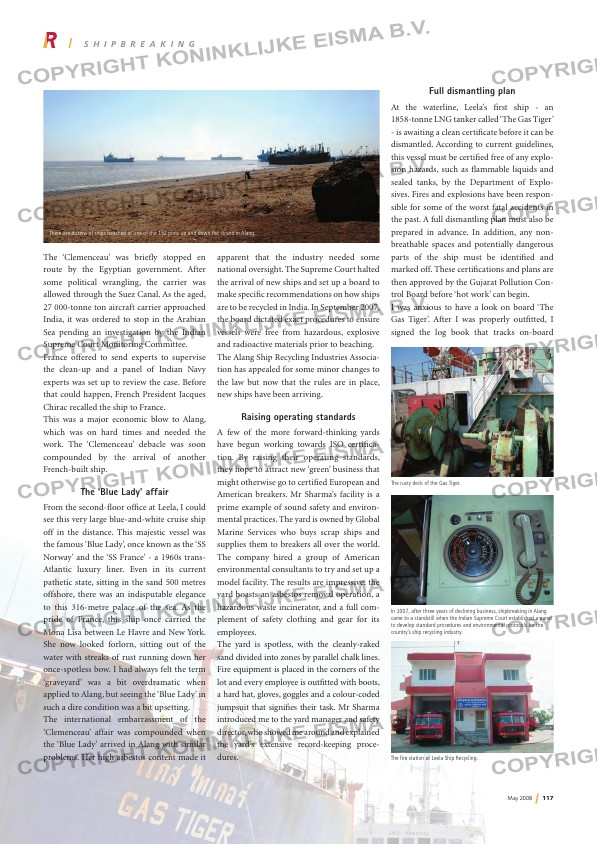Page 117 from: May 2008

May 2008 117
S H I P B R E A K I N G
The ‘Clemenceau’ was briefl y stopped en
route by the Egyptian government. After
some political wrangling, the carrier was
allowed through the Suez Canal. As the aged,
27 000-tonne ton aircraft carrier approached
India, it was ordered to stop in the Arabian
Sea pending an investigation by the Indian
Supreme Court Monitoring Committee.
France offered to send experts to supervise
the clean-up and a panel of Indian Navy
experts was set up to review the case. Before
that could happen, French President Jacques
Chirac recalled the ship to France.
This was a major economic blow to Alang,
which was on hard times and needed the
work. The ‘Clemenceau’ debacle was soon
compounded by the arrival of another
French-built ship.
The ‘Blue Lady’ affair
From the second-fl oor offi ce at Leela, I could
see this very large blue-and-white cruise ship
off in the distance. This majestic vessel was
the famous ‘Blue Lady’, once known as the ‘SS
Norway’ and the ‘SS France’ – a 1960s trans-
Atlantic luxury liner. Even in its current
pathetic state, sitting in the sand 500 metres
offshore, there was an indisputable elegance
to this 316-metre palace of the sea. As the
pride of France, this ship once carried the
Mona Lisa between Le Havre and New York.
She now looked forlorn, sitting out of the
water with streaks of rust running down her
once-spotless bow. I had always felt the term
‘graveyard’ was a bit overdramatic when
applied to Alang, but seeing the ‘Blue Lady’ in
such a dire condition was a bit upsetting.
The international embarrassment of the
‘Clemenceau’ affair was compounded when
the ‘Blue Lady’ arrived in Alang with similar
problems. Her high asbestos content made it
apparent that the industry needed some
national oversight. The Supreme Court halted
the arrival of new ships and set up a board to
make specifi c recommendations on how ships
are to be recycled in India. In September 2007,
the board dictated exact procedures to ensure
vessels were free from hazardous, explosive
and radioactive materials prior to beaching.
The Alang Ship Recycling Industries Associa-
tion has appealed for some minor changes to
the law but now that the rules are in place,
new ships have been arriving.
Raising operating standards
A few of the more forward-thinking yards
have begun working towards ISO certifi ca-
tion. By raising their operating standards,
they hope to attract new ‘green’ business that
might otherwise go to certifi ed European and
American breakers. Mr Sharma’s facility is a
prime example of sound safety and environ-
mental practices. The yard is owned by Global
Marine Services who buys scrap ships and
supplies them to breakers all over the world.
The company hired a group of American
environmental consultants to try and set up a
model facility. The results are impressive: the
yard boasts an asbestos removal operation, a
hazardous waste incinerator, and a full com-
plement of safety clothing and gear for its
employees.
The yard is spotless, with the cleanly-raked
sand divided into zones by parallel chalk lines.
Fire equipment is placed in the corners of the
lot and every employee is outfi tted with boots,
a hard hat, gloves, goggles and a colour-coded
jumpsuit that signifi es their task. Mr Sharma
introduced me to the yard manager and safety
director, who showed me around and explained
the yard’s extensive record-keeping proce-
dures.
Full dismantling plan
At the waterline, Leela’s fi rst ship – an
1858-tonne LNG tanker called ‘The Gas Tiger’
– is awaiting a clean certifi cate before it can be
dismantled. According to current guidelines,
this vessel must be certifi ed free of any explo-
sion hazards, such as fl ammable liquids and
sealed tanks, by the Department of Explo-
sives. Fires and explosions have been respon-
sible for some of the worst fatal accidents in
the past. A full dismantling plan must also be
prepared in advance. In addition, any non-
breathable spaces and potentially dangerous
parts of the ship must be identifi ed and
marked off. These certifi cations and plans are
then approved by the Gujarat Pollution Con-
trol Board before ‘hot work’ can begin.
I was anxious to have a look on board ‘The
Gas Tiger’. After I was properly outfi tted, I
signed the log book that tracks on-board
The rusty deck of the Gas Tiger.
The fi re station at Leela Ship Recycling.
In 2007, after three years of declining business, shipbreaking in Alang
came to a standstill when the Indian Supreme Court established a panel
to develop standard procedures and environmental protocols for the
country’s ship recycling industry.
There are dozens of ships beached at one of the 152 plots up and down the strand in Alang.
RI_023_Shipbreaking.indd 5 14-05-2008 13:53:50



